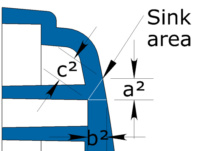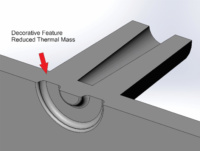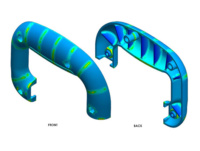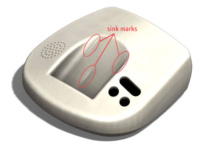How to reduce sink marks of molding defection
Sink marks is popular molded issue, it happens in the region of thick features such as ribs or bosses shrinks more than the material in the adjacent wall. How to reduce sink marks?
We should consider the Factors effecting sink mark depth first:
- Rib / wall thickness ratio.
- Hold time.
- Fillet radii.
- Melt temperature.
- Distance from gate.
- Tool temperature.
- Straight ribs or cross ribs
- Cooling time.
- Hold pressure.
- Material Crystaline / Amorphous.
The presence of such a feature creates an effectively thicker region that cools more slowly than neighboring regions. Differential rates of cooling result in a depression on the adjacent surface that is known as a sink mark.
Modifications to the common core pin can be a simple solution, but don’t expect all resins to behave the same. Gas assist is also worth a try.
This type of defect presents a major limitation to designing and molding plastic products, particularly in thin-wall applications such as TV bezels and display monitors. Parts for consumer electronics must be virtually free of sink marks, while toys often have sink marks clearly visible on their surface.
Formation of sink marks may be due to one or more factors, including the processing methods used, part geometry, material selection, and tooling design. Of these, part geometry and material selection are usually decided by the OEM and may not be easily changed.
However, there are several aspects of tooling design available to the toolmaker that can influence sink. Cooling-channel design, gate type, and gate size can have a wide variety of effects. For example, a small gate such as a tunnel gate freezes off much quicker than an edge gate. Premature gate freeze-off will reduce the available packing time in the cavity, which can increase the likelihood of sink marks.
For the molder, manipulating process conditions is a way to attack sink problems. Packing pressure and time
significantly affect sinks. After a part is filled, additional material is packed into the cavity to reduce the effect of material shrinkage. A shorter packing phase will increase shrinkage, which will result in more or larger sink marks. While the molder can adjust packing conditions to improve sink marks, this approach on its own may not reduce sink marks to an acceptable level.
Other options are mold modifications involving retrofittable components or process modifications such as gas assist or foaming.




